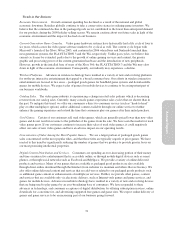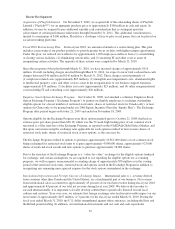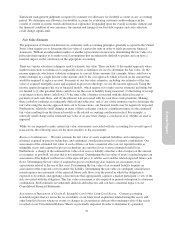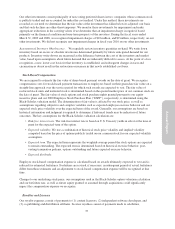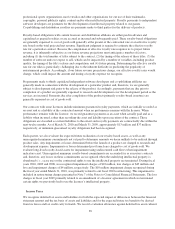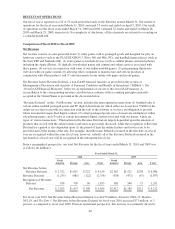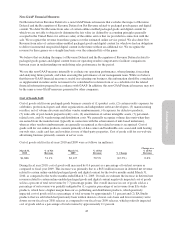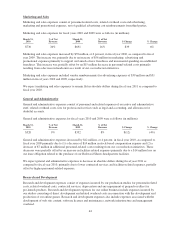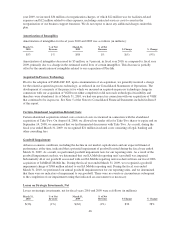Electronic Arts 2010 Annual Report Download - page 114
Download and view the complete annual report
Please find page 114 of the 2010 Electronic Arts annual report below. You can navigate through the pages in the report by either clicking on the pages listed below, or by using the keyword search tool below to find specific information within the annual report.impairment has occurred, management must make various assumptions about the estimated fair value of the asset
by evaluating future business prospects and estimated cash flows. For some assets, our estimated fair value is
dependent upon predicting which of our products will be successful. This success is dependent upon several
factors, which are beyond our control, such as which operating platforms will be successful in the marketplace.
Also, our revenue and earnings are dependent on our ability to meet our product release schedules.
We are required to perform a two-step approach to testing goodwill for impairment for each reporting unit
annually, or whenever events or changes in circumstances indicate the fair value of a reporting unit is below its
carrying amount. Our reporting units are determined by the components of our operating segments that constitute
a business for which (1) discrete financial information is available and (2) segment management regularly
reviews the operating results of that component. We are required to perform the impairment test at least annually
by applying a fair value-based test. The first step measures for impairment by applying fair value-based tests at
the reporting unit level. The second step (if necessary) measures the amount of impairment by applying fair
value-based tests to the individual assets and liabilities within each reporting unit.
To determine the fair value of each reporting unit used in the first step, we use a combination of the market
approach, which utilizes comparable companies’ data, and/or the income approach, which utilizes discounted
cash flows. Each step requires us to make judgments and involves the use of significant estimates and
assumptions. These estimates and assumptions include long-term growth rates and operating margins used to
calculate projected future cash flows, risk-adjusted discount rates based on our weighted average cost of capital,
future economic and market conditions and determination of appropriate market comparables. These estimates
and assumptions have to be made for each reporting unit evaluated for impairment. Our estimates for market
growth, our market share and costs are based on historical data, various internal estimates and certain external
sources, and are based on assumptions that are consistent with the plans and estimates we are using to manage
the underlying business. Our business consists of developing, marketing and distributing video game software
using both established and emerging intellectual properties and our forecasts for emerging intellectual properties
are based upon internal estimates and external sources rather than historical information and have an inherently
higher risk of accuracy. If future forecasts are revised, they may indicate or require future impairment charges.
We base our fair value estimates on assumptions we believe to be reasonable but that are unpredictable and
inherently uncertain. Actual future results may differ from those estimates.
Assessment of Impairment of Short-Term Investments, Marketable Equity Securities and Other Investments. We
periodically review our short-term investments, marketable equity securities and other investments for
impairment. Our short-term investments consist of securities with remaining maturities greater than three months
at the time of purchase and our marketable equity securities consist of investments in common stock of publicly
traded companies, both are accounted for as available-for-sale securities. Unrealized gains and losses on our
short-term investments and marketable equity securities are recorded as a component of accumulated other
comprehensive income in stockholders’ equity, net of tax, until either (1) the security is sold or (2) we determine
that the fair value of the security has declined below its adjusted cost basis and the decline is other-than-
temporary. Realized gains and losses on our short-term investments and marketable equity securities are
calculated based on the specific identification method and are reclassified from accumulated other
comprehensive income to interest and other income, net, and losses on strategic investments, net, respectively.
Determining whether the decline in fair value is other-than-temporary requires management judgment based on
the specific facts and circumstances of each security. The ultimate value realized on these securities is subject to
market price volatility until they are sold. We consider various factors in determining whether we should
recognize an impairment charge, including the credit quality of the issuer, the duration that the fair value has
been less than the adjusted cost basis, severity of the impairment, reason for the decline in value and potential
recovery period, the financial condition and near-term prospects of the investees, and our intent to sell and ability
to hold the investment for a period of time sufficient to allow for any anticipated recovery in market value, any
contractual terms impacting the prepayment or settlement process, as well as, if we would be required to sell an
investment due to liquidity or contractual reasons before its anticipated recovery. During the fiscal year ended
March 31, 2010, 2009 and 2008, we recognized impairment charges of $26 million, $57 million, and $109
million, respectively, on our marketable equity securities. Our ongoing consideration of these factors could result
in additional impairment charges in the future, which could have a material impact on our financial results.
36







